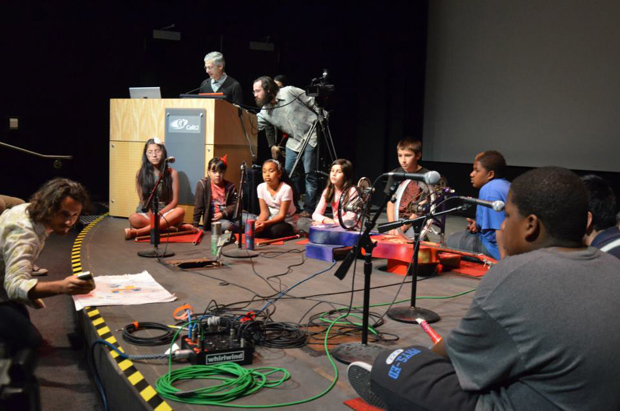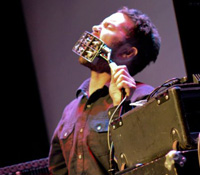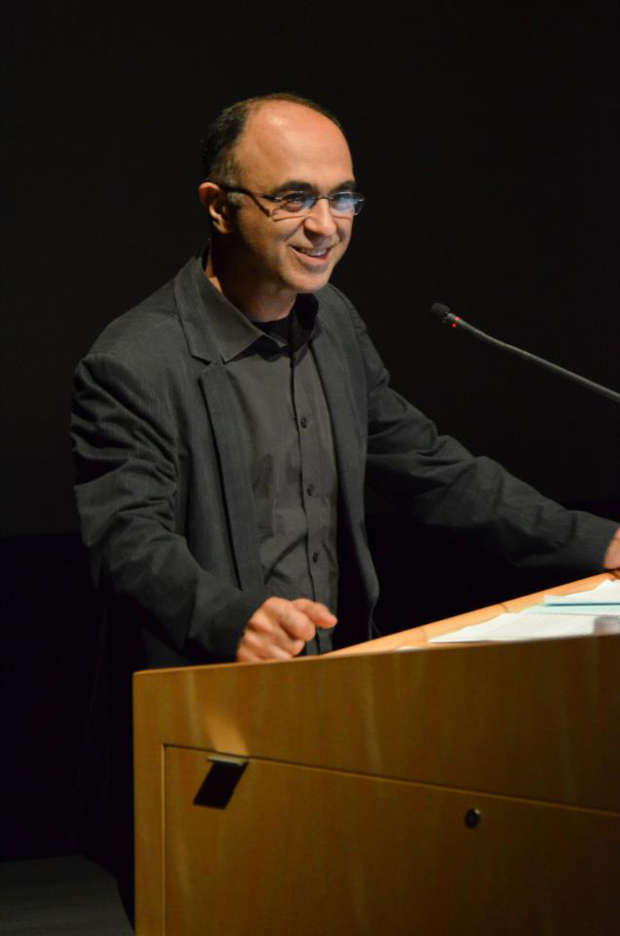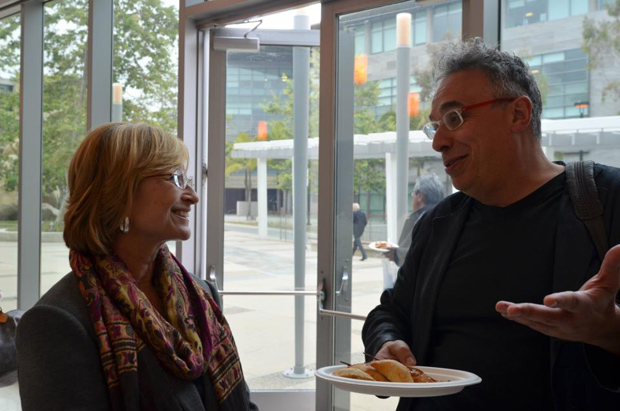
CRCA Reflects Distinguished Past at 40th Anniversary Celebration
By:
- Tiffany Fox
Published Date
By:
- Tiffany Fox
Share This:
Article Content

Participants in the Universal Language Orchestra, which was designed to help children learn about their creativity and about experimental music, also took the stage in Calit2's Atkinson Hall.
It’s the University of California’s oldest arts research center and was one of the University of California, San Diego’s first Organized Research Units. It’s been housed in everything from a converted Marine Corps bowling alley to a state-of-the-art research facility, and in its 40-year history, the Center for Research in Computing and the Arts (CRCA) has been an incubator for myriad experiments at the intersection of culture and computer science research, from computer-spatialized audio and future cinema to video games and virtual reality.

CRCA Research Associate Tristan Shone performs his 'one-man metal band' at CRCA's 40th anniversary celebration. For more photos from the event, visit Calit2's Flickr page.
Formerly known, from 1972 to 1991, as the Center for Music Experiment (CME), CRCA celebrated its fourth decade at UC San Diego last week with a day-long series of demonstrations, lectures and performances at the campus division of the California Institute for Telecommunications and Information Technology (Calit2), where the center is based. Showcased at the event were a selection of performances by representatives of CRCA, including Pulitzer-Prize winning composer Roger Reynolds (performing VOICESPACE I); former director Sheldon Brown’s “Scalable City” animation; an Experimental Music, Theatre and Dance performance and films by several faculty and graduate students affiliated with the Center.
A number of experimental laboratories at CRCA also hosted demonstrations, including the Experimental Game Lab, the Recombinant Media Lab, the Audio Spatialization Lab and a 3D Fabrication Lab, as well as research space for the emerging field of cultural analytics.
In attendance at the celebration were many of the former directors of CME and CRCA, including Reynolds — the founding director of CME from 1972 to 1975 — and Sharokh Yadegari, who currently directs CRCA. They presented a series of recollections and reflections that characterized the research center as, in the words of Reynolds, “a home for individuals to push against all sorts of disciplinary boundaries.”

CRCA Director Sharokh Yadegari
In her remarks, UC San Diego Vice Chancellor for Research Sandra Brown noted that CME made its debut the same year the world’s first pocket calculator was released and John Lennon’s “Instant Karma” became a hit recording. CME’s creation at an auspicious time of “synergistic creativity that surprised and delighted the world” enabled it to “establish the arts as forward-looking, future-oriented and very much focused on what could be,” she added.
“CME and CRCA have placed faculty at the forefront of their fields and in a unique position that we celebrate today,” Brown said, noting that the unit was also the inspiration, in part, for UCSD’s emerging Institute for Digital Exploration in the Arts and Sciences (IDEAS).
Over the course of its history, CRCA and CME have received millions of dollars in research grants for projects spanning a wide variety of topics in new media arts. Composer Reynolds recalled that the $400,000 gift from the Rockefeller Foundation to help establish CME was, at the time, the largest investment that foundation had made in the arts. More recently, in 2010, then-CRCA Director Sheldon Brown and his collaborators were awarded four grants totaling more than $600,000 from the National Science Foundation for research into cultural analytics, virtual reality and software studies.
Affiliated faculty and researchers have also been instrumental in the success of CineGrid, a research collaborative devoted to the future of digital cinema, as well as a number of virtual reality and immersive media conferences around the world. One of the Center’s greatest claims to fame was the creation of Pure Data, a real-time visual programming language developed by former CRCA co-director and UCSD Music Professor Miller Puckette. PD, as it’s more commonly known, has been used to create interactive computer music and multimedia works around the world since its debut in the 1990s.
The 40th anniversary was at the same time celebratory and bittersweet, following the decision last year that CRCA would be disbanded as a campus ORU, after its most recent five-year review. ORUs are designed, by nature, to exist for a limited lifetime, and an effort to propose a new type of ORU was not among the new research centers to be established as ORUs in 2012 (which include, notably, FF-21, Food and Fuel for the 21st Century).

UCSD Vice Chancellor for Research Sandra Brown (left) chats with Visual Arts Professor and CRCA-affiliate Lev Manovich, who is known for his research in cultural analytics.
Nonetheless, several affiliated faculty members and invited guests reiterated that CRCA’s mission and activities would still play a role in future research at the university, beginning with the establishment of a co-op program whereby faculty and graduate students can gain access to CRCA’s former lab space in exchange for playing a role in maintaining the interdisciplinary research community CME/CRCA helped establish.
Calit2 Director Larry Smarr emphasized his commitment to computing and the arts as a foundation of Calit2’s future research agenda. Smarr noted that when the New York Times reported on the opening of Calit2’s Atkinson Hall facility in November 2005, it did so by publishing science writer John Markoff’s article not in its “Science” section, but in its “Arts” section.
“It was obvious when Calit2 was built that the arts should be built in from the ground floor, and new media arts will continue to be at the core of what we do,” said Smarr. “As a scientist, I’ve always been impressed that artists are much better at visualizing the future and its implications than the scientist. Our society’s over-the-horizon radar is in the humanities and arts, and as long as I’m director [of Calit2] we will continue to engage with this community and try to understand the path forward.”
Share This:
You May Also Like
Stay in the Know
Keep up with all the latest from UC San Diego. Subscribe to the newsletter today.


